Art Criticism
Deana Lawson’s Photos Are Stunningly Popular. They’re Also Dangerously Misunderstood
Lawson's elaborate fantasies raise wider questions about the stories that get told about life in a splintering economic order.
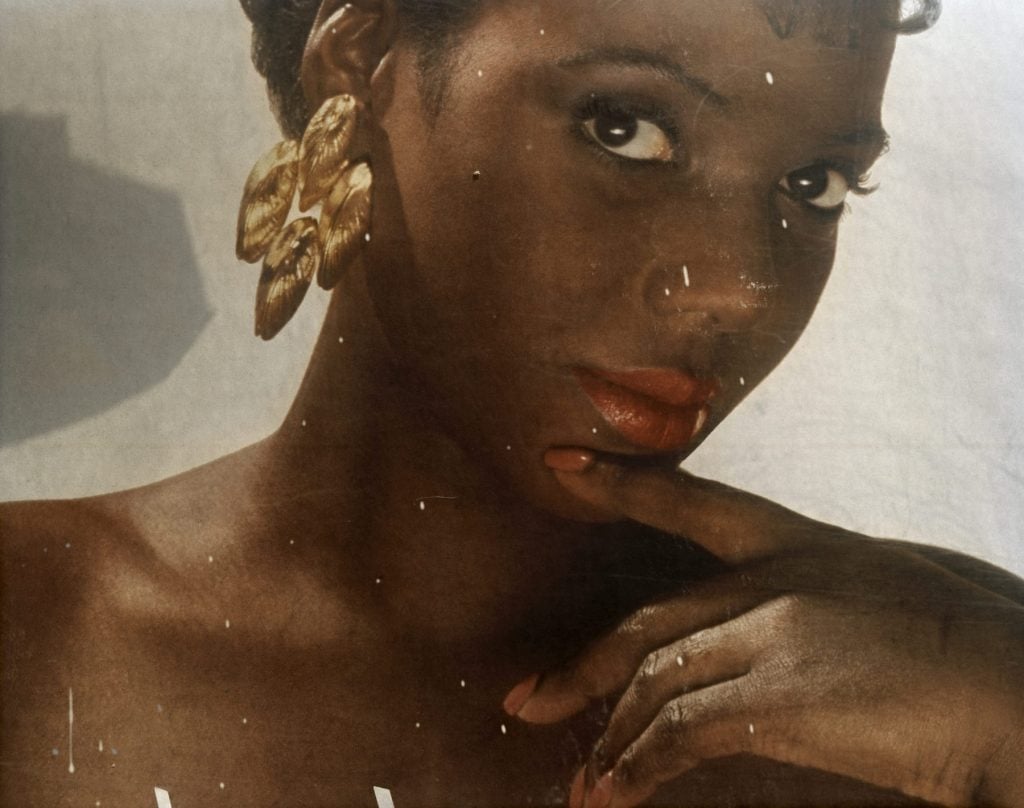
Lawson's elaborate fantasies raise wider questions about the stories that get told about life in a splintering economic order.

Danielle Jackson

In recent years, I’ve thought a lot about the role of the image in the U.S.’s epistemological crisis. New and deeper forms of segregation—economic, residential, and algorithmic—have hampered our ability to visualize American life. This crisis of imagination reveals itself in the work of Deana Lawson, whose large-scale photographs are often referred to as representing “real Black life,” and whose eponymous survey exhibition just finished a successful run at MoMA PS1, traveling to the High Museum on October 7. Lawson has been celebrated everywhere recently, becoming one of the most-visible and most-profiled artists of the last half decade.
The PS1 show attempted to “establish a narrative arc” of the artist’s work over the last fifteen years. In doing so, it presented a tempered view of her elaborate fantasies. A carefully managed narrative of tenderness has taken root in the discourse around Lawson (even as a number of more salacious, rarely exhibited images are reserved for art fairs) to burnish her reputation as a sympathetic chronicler of Black diaspora. Over half of the exhibition’s 50-plus works were drawn from a narrow four-year period (2013-2017) during which some of her most well-known images were made. However, a full review of her exhibition and publishing record—over 125 pieces (excluding commissioned work)—and especially, her pictures of American life, reveals a broader cultural problem of alienation from and even disdain toward those facing precarity in the United States.
In Lawson’s work we find cycles of life, death, and planes in between; from the radiant, numinous, and sexual, to stages of abandonment and disuse. Her large-format pictures have been made during her travels across the United States, the Caribbean, and the African continent. They constitute what she calls a family album of the Black diaspora. She has worked, since 2007, almost exclusively with people she describes as low income or working class. Since 2010, she has incorporated images from African spirituality, and in 2018, she began using appropriated images from outer space. As we are called to the gutter, strip joints, and makeshift environments, we are called to the cosmos: Doves appear on walls, mattresses, and in distant galaxies; humble art-naif paintings become portals tying images across space and time.
There is a genius in how Lawson’s internal logic of veils and windows all hangs together. Photographs of family archives and found images are sometimes rendered in glittering lenticular. Throughout the artist’s 2021 exhibition “Centropy” at the Guggenheim, and in the recent survey at PS1, frames have been crafted from two-inch wide beveled mirrors. They reflect onto the floor, offering a gateway in which to confront the work. Lawson, indeed, has referred to her work as “a mirror of everyday life.”
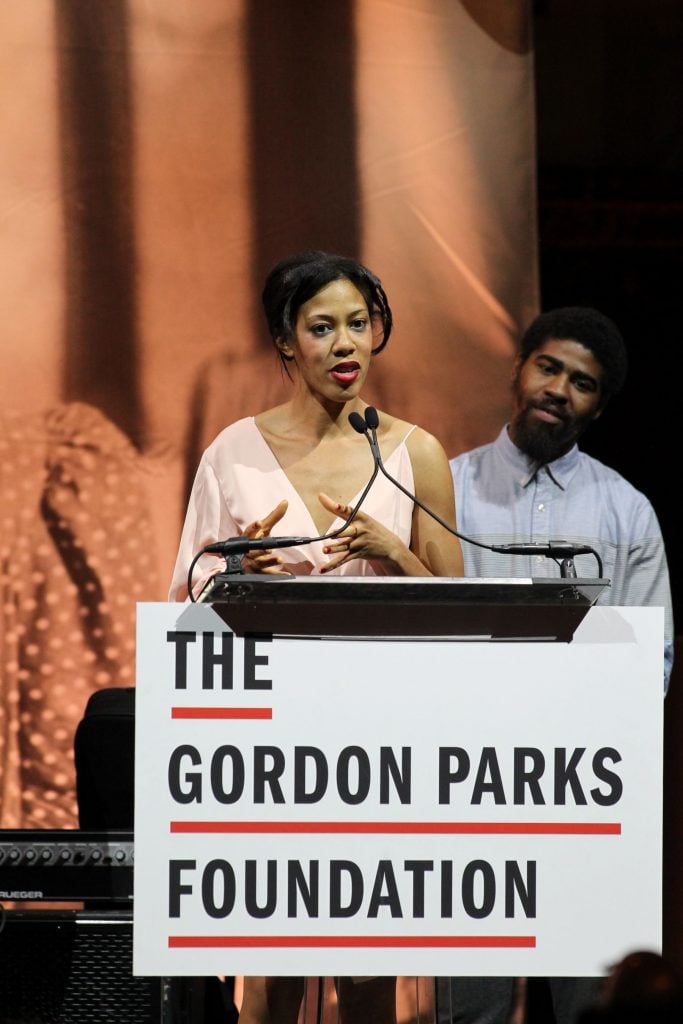
Gordon Parks Foundation fellow Deana Lawson speaks on stage during Gordon Parks Foundation’s 2018 Awards Dinner & Auction at Cipriani in New York City. (Photo by Bennett Raglin/Getty Images for Gordon Parks Foundation)
The name “Centropy,” referencing a theory of a convergence of forces, implies a protective cosmic order. That previous exhibition also marked, if you will, a centropy of institutional support. In the last four years, Lawson has published a monograph with Aperture; organized exhibitions at her gallery, Sikkema Jenkins, as well as Kunsthalle Basel; won the $100,000 Hugo Boss Prize; and published a scholarly catalogue with MACK. She is the winner of the 2022 Deutsche Börse Photography Foundation Prize, and is the subject of this current touring survey exhibition organized by ICA Boston, the High Museum, and MoMA PS1. Her images have influenced the worlds of music and film and have been imitated by a crop of emerging photographers. “I think of myself not only as an artist, but as a force,” she told Vogue in 2021. In keeping with the themes of kin and cosmic relations, Lawson’s work has been the subject of an entire course at Stanford University, taught by the art historian Alexander Nemerov, nephew of Diane Arbus. In 2021, Lawson told Aperture magazine, “I want to be big like Basquiat except I’m using a camera where he was using paints.”
When I first encountered Lawson’s work (I knew her briefly when we worked at the International Center of Photography), I had figured she was interested in formal considerations about the body and the strange ways it could be shaped. For years the unsettling image Adorah (2008), of a premature baby in a funereal gown, was seared into my brain, and signaled to me a deeply peculiar point of view. Nevertheless, her early images are known best for their depictions of affection. Couples embrace (Baby Sleep, 2009; Binky and Tony Forever, 2009); women inspire awe, assuming odalisque poses (Ashanti, 2005, Sharon, 2005); families demonstrate care (Greased Scalp, 2008; Mark Cannon and Friend, 2009; Emerson and Daughter, 2009). In this period, the images were clean and spare, depicting the pristine surfaces of smooth flesh and smoother Naugahyde. Zadie Smith, in 2018, said that Lawson’s work “pulses with love.”
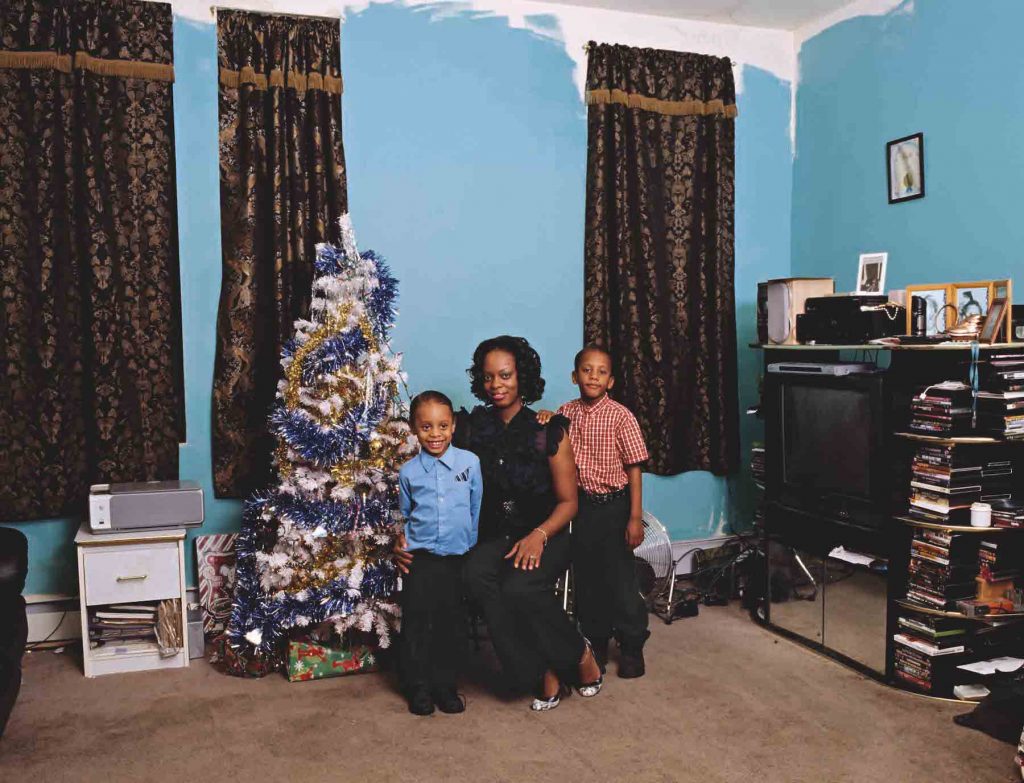
Deana Lawson, Coulson Family (2008). Pigment print. Courtesy the artist; Sikkema Jenkins & Co., New York; and David Kordansky Gallery, Los Angeles. © Deana Lawson
But over time, though, Lawson’s images have grown cluttered, messy, and overripe; walls are rotted with mildew, clothing is shabby, and upholstery shows its foam. Wigs, once neat, grow tangled and fingernails bend into disfiguring claws. Lawson takes pains to show all the rough edges; a woman lifts a dress to reveal a cheap false leg; a crop top reveals a flabby stomach. There are sagging breasts and sagging couches and faces sunken by stress. Most disturbingly, some images find her subjects framed in garbage. In Nikki (2015), a woman in a church basement kneels above bags of empty plastic bottles. In Taneisha’s Gravity (2019), a slovenly woman’s shirt is soiled beyond repair as she sleeps near a trash-filled sofa. In Lawson’s later work, her gaze is often distant and scientific. The effect is macabre, uneasy, and sinister—consumed with literal and metaphorical filth. Writing in the New Yorker, Hilton Als placed Lawson’s work within a psychological terrain where “Black people are greasy artifacts… racist views are celebrated and Blackness is always a curse.” A friend told me of a woman who, perhaps sensing this disturbing energy, wished for a “safe space” apart from white people in which to see “Centropy” by herself.
Lawson says she is concerned with “the majesty of black life,” and the text to “Centropy” stated that she wants to make pictures in which everyday people may be “dignified and resplendent.” A similar conflicted, ambivalent stance can be seen in the photographs of Khalik Allah, or the “public characters” of Maya Stovall‘s Liquor Store Theater—art by two other Black, middle-class artists who have shared an impulse to make the poor appear strange while insisting they are beautiful, vibrant, and divine. For some viewers I know for whom these images do not do enough to subvert our dark history, there is discomfort, a sense the work is a new minstrel show. It’s possible to imagine that Lawson incorporates debasing images to see if we can see past them, but having studied her work and interviews extensively I am still not sure to what extent she is doing this consciously. In this sense, every Lawson image is a lenticular: All the historical baggage is in there, the stereotypical scenes, the wanton sexuality, the transgressive Other, the Black person as the nation’s id—but also, if you turn you head just so, look the other way, you can see the majesty of which Lawson speaks. If you see stereotype, she seems to tease, that’s on you.
Lawson’s 2021 show at Sikkema Jenkins addressed “racial and ecological disorder,” but her interest in enfreakment and defilement has been building over time. Flex (2010), in which a topless woman in thigh-high, spike-heeled boots bends through her legs to peer toward her own crotch, was among the first of Lawson’s images to invoke the sideshow contortionism she would later repeatedly return to in works such as Bendy (2019), Cascade (2019), and White Spider (2019). The ragged mattress, a recurring motif in her recent work, first appeared in Hotel Olofsson Storage Room, Port-au-Prince, Haiti (2015), and has resurfaced in a number of images including House of My Deceased Lover (2019) wherein a box spring appears marked by bedbugs.
Despite Lawson’s desire to affirm the divine within, her often glitchy images undermine her subject’s authority, religious, cultural, or otherwise. In Clearing (2013), a woman appears to prepare a ritual space, but her skirt is unbuttoned, suggesting an enfeebled, almost doddering presence. In Chief (2019), a man in gold ceremonial ornament is positioned aside a smudged, dirty wall below images of Jesus Christ. In Coulson Family (2008), a woman and children pose for standard holiday portrait—but Lawson’s framing of an unfinished paint job deliberately mars an otherwise conventional set-up.
Then, too, there is the fact that a number of Lawson’s works using found photos appear to have been chosen because they are desecrated to some extent. In Emily and Daughter (2018), a studio portrait found in Jamaica, water has worn away two sets of eyes, leaving an eerie, toothy apparitions. In the recent issue of Aperture magazine, Lawson describes how her child scrawled pen across the found image of a sleeping, semi-nude, pregnant woman to create Deleon? Unknown (2020). The class implications of such a negation—scratching poorer people out of sight, or using them as a surface—are hard to ignore.
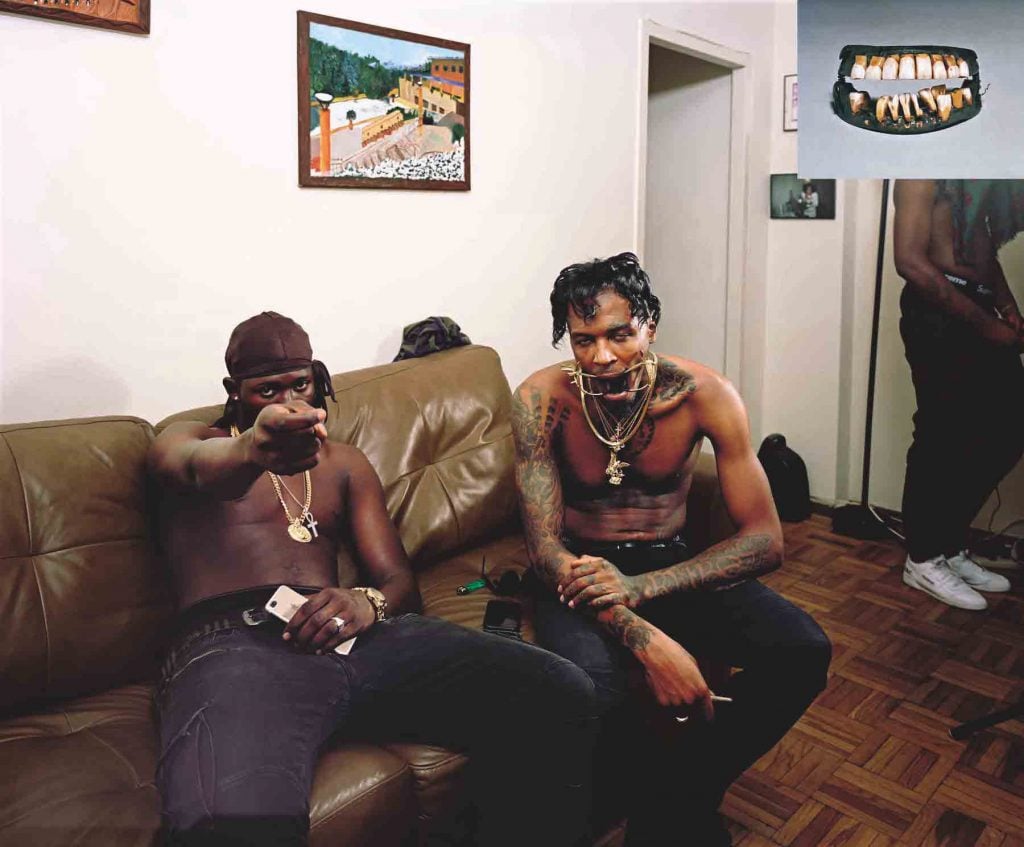
Deana Lawson, Nation (2018). Pigment print and collaged photograph. Courtesy the artist; Sikkema Jenkins & Co., New York; and David Kordansky Gallery, Los Angeles. © Deana Lawson
“I tell my subjects precisely what to do,” Lawson explains. When making a picture, Lawson scouts locations, costumes, and props, and when she works in a subject’s home she may rearrange items to her liking. It is impossible to know what in her pictures is a coincidence and what the result of Lawson’s intervention. (In the selection at PS1, for example, there were three sets of turquoise toenail polish.) Lawson speaks of being driven by inexplicable drives, dreams, and reveries—but these visions are just as likely sourced from the same stuff we call carry around, the culture’s troubled collective unconscious.
Class dynamics are insufficiently articulated in the discussions of Lawson. A middle-class child of working-class Rochester, a city where unemployment was famously high among Black people, she has mentioned becoming aware of the differences between poorer students and herself in high school—in her words, of “witnessing how other people lived.” It is hard to distinguish Lawson’s critique of cultural representation from the gaze formed by her own class fantasies, and it’s hard not to see these fantasies in the images she is both drawn to and stages. We know the kinds of things she adds to her photos from numerous descriptions she has given of their production. A stranger is asked to remove his shirt in Cortez; a young rapper curves his hand in the shape of a trigger in Nation; in Sons of Cush, a hand poking into the frame holds a stack of cash; in Soweto Brother and Sister, a man flashes a “West side” gang symbol; and in Nikki’s Kitchen, a Detroit woman dons a gloved, leopard-print body stocking—an item of clothing her subject definitely did not want to wear, finding it “too tight,” according to Lawson’s own account of the shoot in Vice.
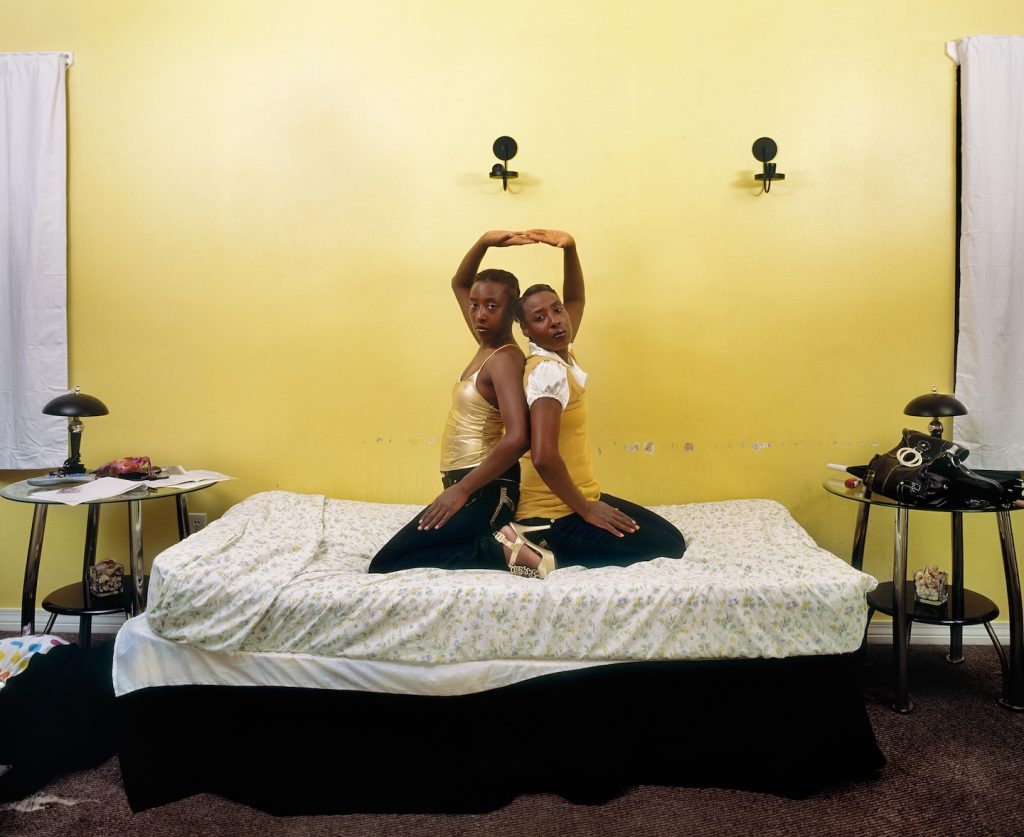
Deana Lawson, Roxie and Raquel New Orleans, Louisiana (2010). Pigment print. 35 × 43 inches (88.9 × 109.2 cm). Collection of the artist. Courtesy the artist; Sikkema Jenkins & Co., New York; and David Kordansky, Los Angeles. © Deana Lawson
An economic underclass, once marginal, is becoming the American mainstream, and it is unclear how traditional stereotypes of lower-income people will endure or shift when nearly half of Americans work in low-wage jobs. In New York City, where Lawson lived during the creation of much of her work, some 44.5 percent of the population is said to live at or near the poverty level. Nationwide, over 40 percent of households are categorized as the working poor. The visual clichés of low-income people—coarse, unkempt, tacky, game for humiliation—have been used to justify segregation and indifference, but the fantasy of an underclass that is separate and distinct from the average American can no longer be entertained. Over the course of the ongoing pandemic, mayors have proposed erecting tent cities for nurses, firefighters, and service workers priced out of the housing market; formerly middle-class families relied on food banks; elementary school teachers supported their incomes on OnlyFans. The collapse of the middle class is altogether upending the illusion of an economic other.
Some might find Lawson’s work a unique affirmation of “ratchet feminism” for its attention to the sexual expression of these low-income Americans. For my own part, I’ve been thinking how the aesthetics of sex work can accompany periods of political instability and economic shock—in Spain after the death of Franco; in the former Yugoslavia, under the reign of Milosevic; in Colombia over the course of its Civil War; in the U.S. during Reaganism and the dismantling of social spending. Lawson first began exhibiting her nudes and portraits of exotic dancers during the global recession of 2009, and her recent accolades have achieved the peak of their fame during the coronavirus pandemic. Her latest exhibitions join a surge of film, TV, music, theater, and photography devoted to the lives of strippers.
Due to a failure to describe Black artists beyond the celebratory, there has been a reluctance to acknowledge the ambiguity of Lawson’s work or its potential broader political contexts. In her blistering review of “Centropy” in Hyperallergic, Gwendolyn DuBois Shaw addressed the lack of criticality around the work, suggesting self-censorship on the part of its interpreters. Lawson herself has said curators “default to me out of fear of not knowing how to talk about the work.” Critics have drawn comparison to the celebrated pictures of U.S. poverty in the ’70s by Danish photographers Jacob Holdt—even as they politely sidestep the accusation of slum tourism long said to have informed Holdt’s gaze. Though her subjects are often enveloped by chaos, decay, and rot, much of the critical discourse has been trapped in the generic language of uplift. Her photographs are said to concern “family, beauty and pride” (ArtReview, 2021) and “black lives and black loves” (Washington Post, 2018); her subjects are “regal, loving, unburdened” (New York Times, 2021); engaged in “communion” (Hyperallergic, 2021) in a “beautiful black universe” (Vice, 2017). This climate of criticism suggests a community unwilling to see, or name, what are often stark pictures of American decline.
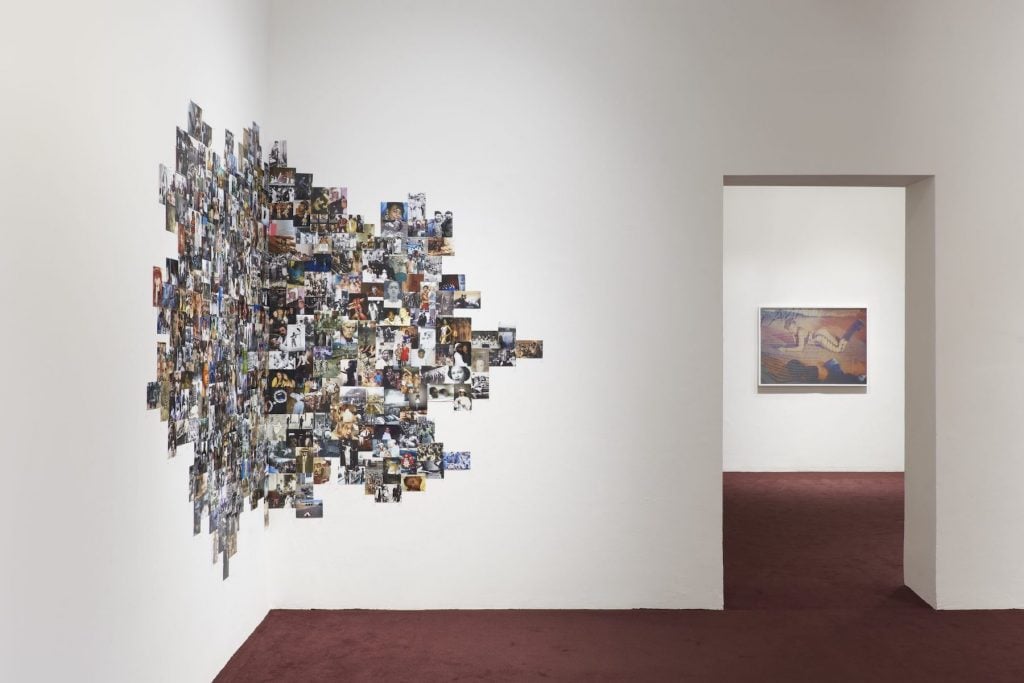
Installation view of exhibition Deana Lawson on view at MoMA PS1 from April 14 to September 5, 2022. Image courtesy MoMA PS1. Photo: Steven Paneccasio.
Lawson has always been clear about her own voyeuristic capacities. As early as 2011, she gently pushed back on the idea that othering was off the table because she herself is Black. Although Lawson has explained her “powerful” attraction to working-class subjects as driven by a recognition of those she knew and loved in Rochester, New York (including her own working-class family), her work stands as a clear reminder that one doesn’t always identify with that which one is familiar. At times Lawson’s relationships to her subjects even intimate illicit libidinal desires, the secret dreams of a good girl breaking bad. In Lawson’s first publication, Corporeal (2009), she describes the sensation of men gazing upon her and her subject, Barbara, as they combed the streets of Brooklyn in search of a wine opener:
I think many of the men we passed looked at us with questioning eyes. How did we look to them? … Barbara was wearing tight white leather pants with a black head scarf tied at her forehead. I was wearing tight pinstriped jeans and red lipstick carrying the wine. We could’ve been mistaken for whores … I just hoped I didn’t see someone from church.
In Lawson’s fantasies, and her attraction to “sexy mothers,“ “acrylic nails,” and “weaves on pavement,” I read a symptom of a familiar kind of cultural dislocation on the part of some Black artists. As they are drawn into elite institutions, a younger generation of artists and photographers has embraced visual tropes from a longed-for, yet essentialized, working-class Black experience, using a stock set of signifiers like nails, gold-capped teeth, bamboo earrings, and durags. (Sometimes this dissonance goes so far as to elevate these items into luxury products marketed to other Blacks. Behold: a single hair roller, dipped in gold, for $220, sold as reverentially as a tribute to “the styles of our fore-mothers”).
The sociologist Pierre Bourdieu called this dynamic habitus clivé, an experience of extreme social mobility that leaves one with an irreconcilable nostalgia for a place one may never return. Though such symbols can be consumed with sincere affection, class alienation and the desire to relate and belong can lead to regrettable distortions. Is Lawson’s work staging of scenes in this vein somehow connected to the same psychic energies that inspired the so-called “ratchet parties” of a few years ago, where Black professionals danced to trap music in a class-exclusive setting? Is it like the story of “T-Bone,” Cory Booker’s street friend who proved to be made up? Is it similar to the animal prints and miniskirts worn by white academics who were found to be passing as Black?
Nearly one hundred years ago, as blacks moved to new fortune in the industrial north, writers of the Harlem Renaissance debated the value of Southern folkways, which some aped for their cultural vitality. The case of Zora Neale Hurston—whom Lawson has frequently cited as an inspiration—is instructive. The famed author’s use of dialect was seen by some critics as resistance to assimilation, but to others, primitivism. The scholar Hazel Carby and others have criticized Hurston’s vigorous embrace of “the Folk” as the psychological completion of a college-educated Black migrant. I hear an echo of this in Lawson’s statement: “My own being is found in union with those I take pictures of.” In all of these instincts towards the working class, I see also Melanie Klein’s projective identification—idealizing yet keeping at arms-length that which can never be integrated, asking instead for others to perform as you imagine them.
As America grows divided, and it becomes impossible to know the other, fantasies fill the gap, facilitating a crisis of the real. Lawson is hardly alone in pursuing a kind of surrealism to depict communities facing social and economic marginalization. In fact, a new set of tropes have developed. There are the “humid, hallucinatory” photographs of Curran Hatleberg; the “psychedelic” images by Gregory Halpern; the lyrical, “meditative” pictures by Holly Lynton; the somewhat gonzo, drug-addled approach of Stacy Kranitz (the onetime “Instagram Photographer of the Year” has even slept with her subjects in Appalachia). Consider, even, the dramatic pictures from a Polish live-action role play emulating life in Ohio, which Americans on social media believed to be accurate. These celebrated depictions of “ordinary Americans” imagine swaths of the United States as a mystical place of fever dreams.
At times, I have welcomed Lawson’s experiment in photographing Black people beyond the sentimental or the ultra-glamorous. I like the possibility that the Black image is no longer a site of remediation, freed from a loop of the affirmative, where beauty, decency, and an outsiders’ understanding are primary aesthetic concerns. To be clear, I don’t believe a person must be photographed the way they want to be seen. And in no way do I believe that social realism, or even empathy, is the only admissible artistic position towards the victims of middle-class collapse. But I do wonder, politically, as ruin advances ever upward, how long can this kind of mystification be sustained. Such misperceptions of the near-majority leave us deeply unprepared to face our current crises. I fear the unknowability of entire groups has settled in just as people need to see each other clearly.
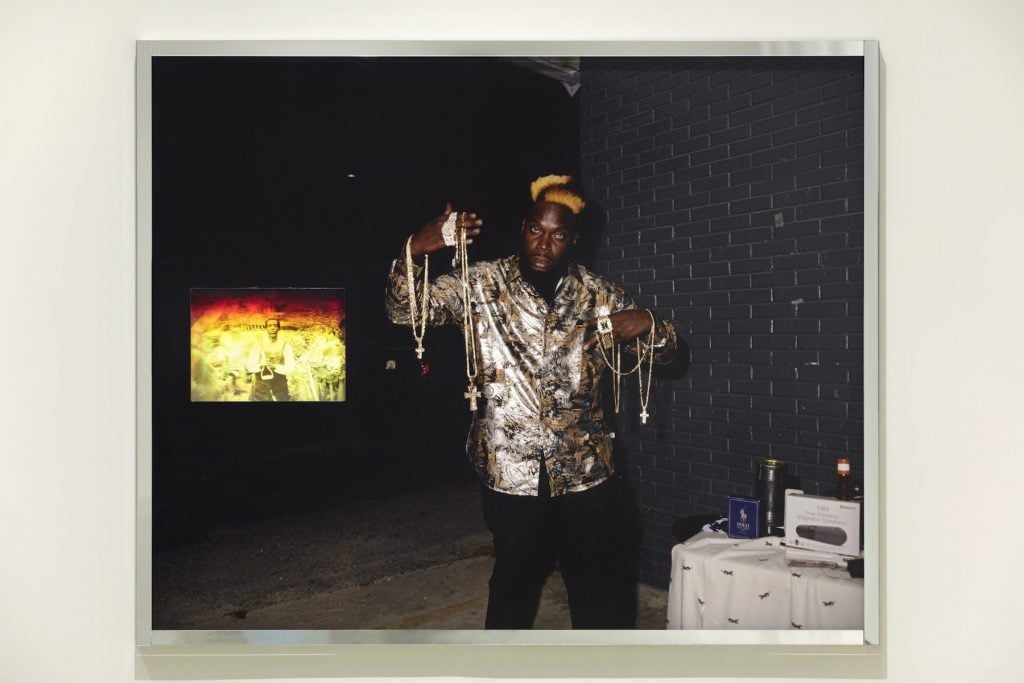
Deana Lawson, Black Gold (“Earth turns to gold, in the hands of the wise,” Rumi) (2021). Pigment print with embedded hologram. Courtesy the artist; Sikkema Jenkins & Co., New York; and David Kordansky Gallery, Los Angeles. © Deana Lawson
When I saw Lawson’s “Centropy” at the Guggenheim, the set of photographs that flashed to my mind as a point of comparison were those on the Instagram page of Darnella Frazier, the teenage girl from Minneapolis who was awarded an honorary Pulitzer Prize for filming the death of George Floyd. In most of Frazier’s posts, she sits before a smudged mirror, admiring a manicure or a new wig. Reflected in her background is a dim, humble room, sparse furniture, and a rumpled, unmade bed.
Within a day of scrolling through Frazier’s universe, the Instagram algorithm identified me, suddenly, as a different kind of consumer. I saw, then, my first ad for a Brazilian Butt Lift. Things became progressively strange. A woman in a surgical g-string danced seductively with a port sticking out of her midsection. A mother posed in a full-body tiger-striped unitard astride her spandexed, tiger-clad baby. Soon followed videos for elaborate, appliquéd hair weaves and a guide to shaping long acrylic nails into “stilettos,” “coffins,” and “tapered squares.” More importantly, gone were the images of well-oiled, puffy-haired women of the Black creative class, photographed with their houseplants in loose-fitting tunics. Ads for what I called “gentrifier underwear”—with sexless, mousy haired women in serious, thick cotton panties—had been replaced by videos of sparkly crotch-out lingerie sets, on sale for 60 percent off. I had entered a portal to another dimension. It was remarkable to see the narrow set of aesthetics ascribed to this group.
For one moment at Lawson’s Guggenheim show, the astral was brought back to earth. At the center of the room was Torus (2021), a hologram reminiscent of the cosmic doughnut-shaped ring observed in astronomy. In due time, I would come to appreciate the torus as the perfect metaphor for the experience of consolidation and fragmentation found in art, media, film, cities, and national identity. A black hole forms when a star collapses under the weight of its own gravity, capturing everything in its path, encircled by a ring of gas and dust…
But in that moment, another meaning arose before me in the form of a tall white man who briskly entered the gallery casting a long arm at Torus, which the curators described as a symbol of spiritual presence. Uncomfortable with the display all around him, and averting his eyes from the rest of the work, he fixated on the hologram. “Walk in a straight line, and you’ll see it,” he said loudly, directing anyone within earshot to the center of the room. “It’s a black hole,” he kept repeating, as Lawson’s female nudes hovered just behind him. “A black hole,” he murmured, saying little else. Strangely, the racial connotations, the crassly sexual connotations, didn’t seem to even occur to him.
It’s possible to see what is happening and still not see at all.
Two days later I am balled up in bed, immersed in the sentencing of a serial killer who targeted economically vulnerable Black women in New Jersey. Among the four victims were community-college students, pregnant women, sex workers, and the unhoused. As I Google photographs of these women I notice the banality of their dress: tame button-downs and fuzzy sweaters, clean makeup and bright smiles, modest headscarves and neat dreadlocks—on the whole, not so different than the photos Lawson takes of herself. I think about how different they look from the unending fantastical projections placed upon their social class, and how seldom their real world is mirrored back.